The QWizard class provides a framework for wizards. 更多...
| 头: | #include <QWizard> |
| qmake: | QT += widgets |
| Since: | Qt 4.3 |
| 继承: | QDialog |
| enum | WizardButton { BackButton, NextButton, CommitButton, FinishButton, ..., Stretch } |
| enum | WizardOption { IndependentPages, IgnoreSubTitles, ExtendedWatermarkPixmap, NoDefaultButton, ..., NoCancelButtonOnLastPage } |
| flags | WizardOptions |
| enum | WizardPixmap { WatermarkPixmap, LogoPixmap, BannerPixmap, BackgroundPixmap } |
| enum | WizardStyle { ClassicStyle, ModernStyle, MacStyle, AeroStyle } |
|
| QWizard (QWidget * parent = Q_NULLPTR, Qt::WindowFlags flags = Qt::WindowFlags()) | |
| ~QWizard () | |
| int | addPage (QWizardPage * page ) |
| QAbstractButton * | button (WizardButton which ) const |
| QString | buttonText (WizardButton which ) const |
| int | currentId () const |
| QWizardPage * | currentPage () const |
| QVariant | field (const QString & name ) const |
| bool | hasVisitedPage (int id ) const |
| virtual int | nextId () const |
| WizardOptions | options () const |
| QWizardPage * | page (int id ) const |
| QList<int> | pageIds () const |
| QPixmap | pixmap (WizardPixmap which ) const |
| void | removePage (int id ) |
| void | setButton (WizardButton which , QAbstractButton * button ) |
| void | setButtonLayout (const QList<WizardButton> & layout ) |
| void | setButtonText (WizardButton which , const QString & text ) |
| void | setDefaultProperty (const char * className , const char * property , const char * changedSignal ) |
| void | setField (const QString & name , const QVariant & value ) |
| void | setOption (WizardOption option , bool on = true) |
| void | setOptions (WizardOptions options ) |
| void | setPage (int id , QWizardPage * page ) |
| void | setPixmap (WizardPixmap which , const QPixmap & pixmap ) |
| void | setSideWidget (QWidget * widget ) |
| void | setStartId (int id ) |
| void | setSubTitleFormat (Qt::TextFormat format ) |
| void | setTitleFormat (Qt::TextFormat format ) |
| void | setWizardStyle (WizardStyle style ) |
| QWidget * | sideWidget () const |
| int | startId () const |
| Qt::TextFormat | subTitleFormat () const |
| bool | testOption (WizardOption option ) const |
| Qt::TextFormat | titleFormat () const |
| virtual bool | validateCurrentPage () |
| QList<int> | visitedPages () const |
| WizardStyle | wizardStyle () const |
| virtual void | setVisible (bool visible ) |
| virtual QSize | sizeHint () const |
| void | back () |
| void | next () |
| void | restart () |
| void | currentIdChanged (int id ) |
| void | customButtonClicked (int which ) |
| void | helpRequested () |
| void | pageAdded (int id ) |
| void | pageRemoved (int id ) |
| virtual void | cleanupPage (int id ) |
| virtual void | initializePage (int id ) |
| virtual void | done (int result ) |
| virtual bool | event (QEvent * event ) |
| virtual bool | nativeEvent (const QByteArray & eventType , void * message , long * result ) |
| virtual void | paintEvent (QPaintEvent * event ) |
| virtual void | resizeEvent (QResizeEvent * event ) |
The QWizard class provides a framework for wizards.
A wizard (also called an assistant on macOS) is a special type of input dialog that consists of a sequence of pages. A wizard's purpose is to guide the user through a process step by step. Wizards are useful for complex or infrequent tasks that users may find difficult to learn.
QWizard 继承 QDialog and represents a wizard. Each page is a QWizardPage (a QWidget subclass). To create your own wizards, you can use these classes directly, or you can subclass them for more control.
话题:
The following example illustrates how to create wizard pages and add them to a wizard. For more advanced examples, see Class Wizard and License Wizard .
QWizardPage *createIntroPage() { QWizardPage *page = new QWizardPage; page->setTitle("Introduction"); QLabel *label = new QLabel("This wizard will help you register your copy " "of Super Product Two."); label->setWordWrap(true); QVBoxLayout *layout = new QVBoxLayout; layout->addWidget(label); page->setLayout(layout); return page; } QWizardPage *createRegistrationPage() { ... } QWizardPage *createConclusionPage() { ... } int main(int argc, char *argv[]) { QApplication app(argc, argv); #ifndef QT_NO_TRANSLATION QString translatorFileName = QLatin1String("qt_"); translatorFileName += QLocale::system().name(); QTranslator *translator = new QTranslator(&app); if (translator->load(translatorFileName, QLibraryInfo::location(QLibraryInfo::TranslationsPath))) app.installTranslator(translator); #endif QWizard wizard; wizard.addPage(createIntroPage()); wizard.addPage(createRegistrationPage()); wizard.addPage(createConclusionPage()); wizard.setWindowTitle("Trivial Wizard"); wizard.show(); return app.exec(); }
QWizard supports four wizard looks:
You can explicitly set the look to use using setWizardStyle () (e.g., if you want the same look on all platforms).
| ClassicStyle | ModernStyle | MacStyle | AeroStyle |
|---|---|---|---|
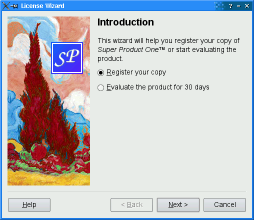
|
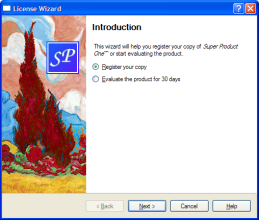
|
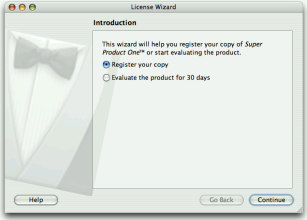
|
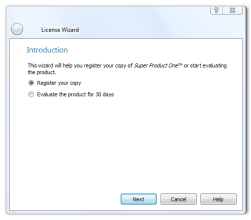
|

|

|
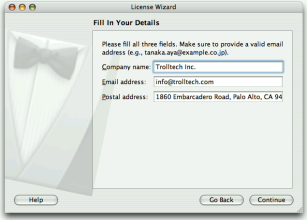
|

|
注意: AeroStyle has effect only on a Windows Vista system with alpha compositing enabled. ModernStyle is used as a fallback when this condition is not met.
In addition to the wizard style, there are several options that control the look and feel of the wizard. These can be set using setOption () 或 setOptions (). For example, HaveHelpButton 使 QWizard show a 帮助 button along with the other wizard buttons.
You can even change the order of the wizard buttons to any arbitrary order using setButtonLayout (), and you can add up to three custom buttons (e.g., a 打印 button) to the button row. This is achieved by calling setButton () 或 setButtonText () 采用 CustomButton1 , CustomButton2 ,或 CustomButton3 to set up the button, and by enabling the HaveCustomButton1 , HaveCustomButton2 ,或 HaveCustomButton3 options. Whenever the user clicks a custom button, customButtonClicked () is emitted. For example:
wizard()->setButtonText(QWizard::CustomButton1, tr("&Print"));
wizard()->setOption(QWizard::HaveCustomButton1, true);
connect(wizard(), &QWizard::customButtonClicked,
this, &ConclusionPage::printButtonClicked);
Wizards consist of a sequence of QWizardPage s. At any time, only one page is shown. A page has the following attributes:
The diagram belows shows how QWizard renders these attributes, assuming they are all present and ModernStyle is used:
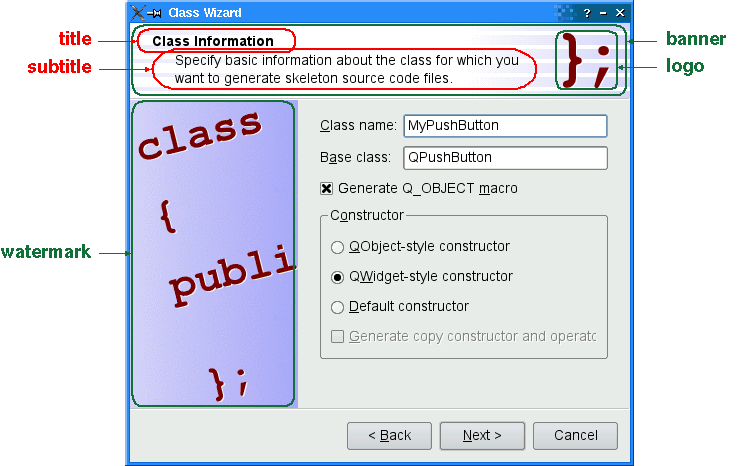
当 subTitle 有设置, QWizard displays it in a header, in which case it also uses the BannerPixmap 和 LogoPixmap to decorate the header. The WatermarkPixmap is displayed on the left side, below the header. At the bottom, there is a row of buttons allowing the user to navigate through the pages.
The page itself (the QWizardPage widget) occupies the area between the header, the watermark, and the button row. Typically, the page is a QWizardPage on which a QGridLayout is installed, with standard child widgets ( QLabel s, QLineEdit s, etc.).
若向导风格为 MacStyle ,页面看起来完全不同:
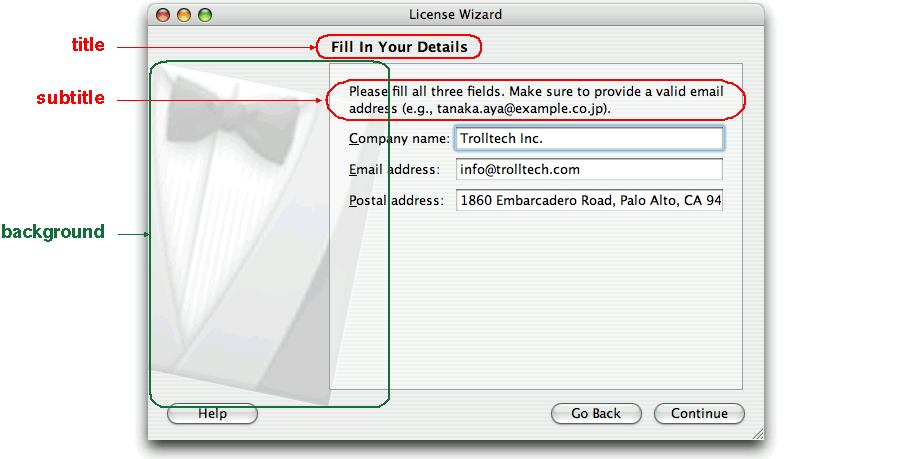
The watermark, banner, and logo pixmaps are ignored by the MacStyle 。若 BackgroundPixmap is set, it is used as the background for the wizard; otherwise, a default "assistant" image is used.
The title and subtitle are set by calling QWizardPage::setTitle () 和 QWizardPage::setSubTitle () on the individual pages. They may be plain text or HTML (see titleFormat and subTitleFormat ). The pixmaps can be set globally for the entire wizard using setPixmap (), or on a per-page basis using QWizardPage::setPixmap ().
In many wizards, the contents of a page may affect the default values of the fields of a later page. To make it easy to communicate between pages, QWizard supports a "field" mechanism that allows you to register a field (e.g., a QLineEdit ) on a page and to access its value from any page. It is also possible to specify mandatory fields (i.e., fields that must be filled before the user can advance to the next page).
To register a field, call QWizardPage::registerField () field. For example:
ClassInfoPage::ClassInfoPage(QWidget *parent) : QWizardPage(parent) { ... classNameLabel = new QLabel(tr("&Class name:")); classNameLineEdit = new QLineEdit; classNameLabel->setBuddy(classNameLineEdit); baseClassLabel = new QLabel(tr("B&ase class:")); baseClassLineEdit = new QLineEdit; baseClassLabel->setBuddy(baseClassLineEdit); qobjectMacroCheckBox = new QCheckBox(tr("Generate Q_OBJECT ¯o")); registerField("className*", classNameLineEdit); registerField("baseClass", baseClassLineEdit); registerField("qobjectMacro", qobjectMacroCheckBox); ... }
The above code registers three fields,
className
,
baseClass
,和
qobjectMacro
, which are associated with three child widgets. The asterisk (
*
) next to
className
denotes a mandatory field.
The fields of any page are accessible from any other page. For example:
void OutputFilesPage::initializePage() { QString className = field("className").toString(); headerLineEdit->setText(className.toLower() + ".h"); implementationLineEdit->setText(className.toLower() + ".cpp"); outputDirLineEdit->setText(QDir::toNativeSeparators(QDir::tempPath())); }
这里,调用
QWizardPage::field
() to access the contents of the
className
field (which was defined in the
ClassInfoPage
) and use it to initialize the
OutputFilePage
. The field's contents is returned as a
QVariant
.
When we create a field using QWizardPage::registerField (), we pass a unique field name and a widget. We can also provide a Qt property name and a "changed" signal (a signal that is emitted when the property changes) as third and fourth arguments; however, this is not necessary for the most common Qt widgets, such as QLineEdit , QCheckBox ,和 QComboBox ,因为 QWizard knows which properties to look for.
If an asterisk (
*
) is appended to the name when the property is registered, the field is a
mandatory field
. When a page has mandatory fields, the
下一
and/or
Finish
buttons are enabled only when all mandatory fields are filled.
To consider a field "filled", QWizard simply checks that the field's current value doesn't equal the original value (the value it had when initializePage () was called). For QLineEdit and QAbstractSpinBox 子类, QWizard also checks that hasAcceptableInput() returns true, to honor any validator or mask.
QWizard 's mandatory field mechanism is provided for convenience. A more powerful (but also more cumbersome) alternative is to reimplement QWizardPage::isComplete () and to emit the QWizardPage::completeChanged () signal whenever the page becomes complete or incomplete.
The enabled/disabled state of the
下一
and/or
Finish
buttons is one way to perform validation on the user input. Another way is to reimplement
validateCurrentPage
() (或
QWizardPage::validatePage
()) to perform some last-minute validation (and show an error message if the user has entered incomplete or invalid information). If the function returns
true
, the next page is shown (or the wizard finishes); otherwise, the current page stays up.
Most wizards have a linear structure, with page 1 followed by page 2 and so on until the last page. The Class Wizard example is such a wizard. With QWizard , linear wizards are created by instantiating the QWizardPage s and inserting them using addPage (). By default, the pages are shown in the order in which they were added. For example:
ClassWizard::ClassWizard(QWidget *parent) : QWizard(parent) { addPage(new IntroPage); addPage(new ClassInfoPage); addPage(new CodeStylePage); addPage(new OutputFilesPage); addPage(new ConclusionPage); ... }
When a page is about to be shown, QWizard calls initializePage () (which in turn calls QWizardPage::initializePage ()) to fill the page with default values. By default, this function does nothing, but it can be reimplemented to initialize the page's contents based on other pages' fields (see the 以上范例 ).
If the user presses Back , cleanupPage () is called (which in turn calls QWizardPage::cleanupPage ()). The default implementation resets the page's fields to their original values (the values they had before initializePage () was called). If you want the Back button to be non-destructive and keep the values entered by the user, simply enable the IndependentPages 选项。
Some wizards are more complex in that they allow different traversal paths based on the information provided by the user. The License Wizard example illustrates this. It provides five wizard pages; depending on which options are selected, the user can reach different pages.
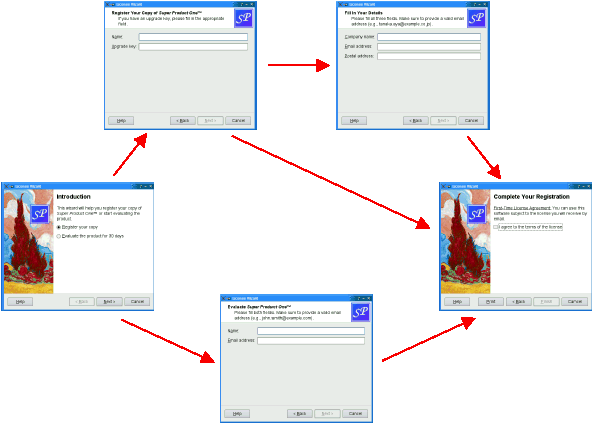
In complex wizards, pages are identified by IDs. These IDs are typically defined using an enum. For example:
class LicenseWizard : public QWizard { ... enum { Page_Intro, Page_Evaluate, Page_Register, Page_Details, Page_Conclusion }; ... };
The pages are inserted using setPage (), which takes an ID and an instance of QWizardPage (or of a subclass):
LicenseWizard::LicenseWizard(QWidget *parent) : QWizard(parent) { setPage(Page_Intro, new IntroPage); setPage(Page_Evaluate, new EvaluatePage); setPage(Page_Register, new RegisterPage); setPage(Page_Details, new DetailsPage); setPage(Page_Conclusion, new ConclusionPage); ... }
By default, the pages are shown in increasing ID order. To provide a dynamic order that depends on the options chosen by the user, we must reimplement QWizardPage::nextId ()。例如:
int IntroPage::nextId() const { if (evaluateRadioButton->isChecked()) { return LicenseWizard::Page_Evaluate; } else { return LicenseWizard::Page_Register; } } int EvaluatePage::nextId() const { return LicenseWizard::Page_Conclusion; } int RegisterPage::nextId() const { if (upgradeKeyLineEdit->text().isEmpty()) { return LicenseWizard::Page_Details; } else { return LicenseWizard::Page_Conclusion; } } int DetailsPage::nextId() const { return LicenseWizard::Page_Conclusion; } int ConclusionPage::nextId() const { return -1; }
It would also be possible to put all the logic in one place, in a QWizard::nextId () 重实现。例如:
int LicenseWizard::nextId() const { switch (currentId()) { case Page_Intro: if (field("intro.evaluate").toBool()) { return Page_Evaluate; } else { return Page_Register; } case Page_Evaluate: return Page_Conclusion; case Page_Register: if (field("register.upgradeKey").toString().isEmpty()) { return Page_Details; } else { return Page_Conclusion; } case Page_Details: return Page_Conclusion; case Page_Conclusion: default: return -1; } }
To start at another page than the page with the lowest ID, call setStartId ().
To test whether a page has been visited or not, call hasVisitedPage ()。例如:
void ConclusionPage::initializePage() { QString licenseText; if (wizard()->hasVisitedPage(LicenseWizard::Page_Evaluate)) { licenseText = tr("<u>Evaluation License Agreement:</u> " "You can use this software for 30 days and make one " "backup, but you are not allowed to distribute it."); } else if (wizard()->hasVisitedPage(LicenseWizard::Page_Details)) { licenseText = tr("<u>First-Time License Agreement:</u> " "You can use this software subject to the license " "you will receive by email."); } else { licenseText = tr("<u>Upgrade License Agreement:</u> " "This software is licensed under the terms of your " "current license."); } bottomLabel->setText(licenseText); }
另请参阅 QWizardPage , 类向导范例 ,和 许可向导范例 .
此枚举指定向导中的按钮。
| 常量 | 值 | 描述 |
|---|---|---|
QWizard::BackButton
|
0
|
The Back button ( Go Back on macOS) |
QWizard::NextButton
|
1
|
The 下一 button ( Continue on macOS) |
QWizard::CommitButton
|
2
|
The Commit button |
QWizard::FinishButton
|
3
|
The Finish button ( Done on macOS) |
QWizard::CancelButton
|
4
|
The Cancel button (see also NoCancelButton ) |
QWizard::HelpButton
|
5
|
The 帮助 button (see also HaveHelpButton ) |
QWizard::CustomButton1
|
6
|
The first user-defined button (see also HaveCustomButton1 ) |
QWizard::CustomButton2
|
7
|
The second user-defined button (see also HaveCustomButton2 ) |
QWizard::CustomButton3
|
8
|
The third user-defined button (see also HaveCustomButton3 ) |
The following value is only useful when calling setButtonLayout ():
| 常量 | 值 | 描述 |
|---|---|---|
QWizard::Stretch
|
9
|
A horizontal stretch in the button layout |
另请参阅 setButton (), setButtonText (), setButtonLayout (),和 customButtonClicked ().
This enum specifies various options that affect the look and feel of a wizard.
| 常量 | 值 | 描述 |
|---|---|---|
QWizard::IndependentPages
|
0x00000001
|
The pages are independent of each other (i.e., they don't derive values from each other). |
QWizard::IgnoreSubTitles
|
0x00000002
|
Don't show any subtitles, even if they are set. |
QWizard::ExtendedWatermarkPixmap
|
0x00000004
|
Extend any WatermarkPixmap all the way down to the window's edge. |
QWizard::NoDefaultButton
|
0x00000008
|
Don't make the 下一 or Finish button the dialog's 默认按钮 . |
QWizard::NoBackButtonOnStartPage
|
0x00000010
|
Don't show the Back button on the start page. |
QWizard::NoBackButtonOnLastPage
|
0x00000020
|
Don't show the Back button on the last page. |
QWizard::DisabledBackButtonOnLastPage
|
0x00000040
|
Disable the Back button on the last page. |
QWizard::HaveNextButtonOnLastPage
|
0x00000080
|
Show the (disabled) 下一 button on the last page. |
QWizard::HaveFinishButtonOnEarlyPages
|
0x00000100
|
Show the (disabled) Finish button on non-final pages. |
QWizard::NoCancelButton
|
0x00000200
|
Don't show the Cancel 按钮。 |
QWizard::CancelButtonOnLeft
|
0x00000400
|
Put the Cancel button on the left of Back (rather than on the right of Finish or 下一 ). |
QWizard::HaveHelpButton
|
0x00000800
|
Show the 帮助 按钮。 |
QWizard::HelpButtonOnRight
|
0x00001000
|
Put the 帮助 button on the far right of the button layout (rather than on the far left). |
QWizard::HaveCustomButton1
|
0x00002000
|
Show the first user-defined button ( CustomButton1 ). |
QWizard::HaveCustomButton2
|
0x00004000
|
Show the second user-defined button ( CustomButton2 ). |
QWizard::HaveCustomButton3
|
0x00008000
|
Show the third user-defined button ( CustomButton3 ). |
QWizard::NoCancelButtonOnLastPage
|
0x00010000
|
Don't show the Cancel button on the last page. |
The WizardOptions type is a typedef for QFlags <WizardOption>. It stores an OR combination of WizardOption values.
另请参阅 setOptions (), setOption (),和 testOption ().
This enum specifies the pixmaps that can be associated with a page.
| 常量 | 值 | 描述 |
|---|---|---|
QWizard::WatermarkPixmap
|
0
|
The tall pixmap on the left side of a ClassicStyle or ModernStyle page |
QWizard::LogoPixmap
|
1
|
The small pixmap on the right side of a ClassicStyle or ModernStyle page header |
QWizard::BannerPixmap
|
2
|
The pixmap that occupies the background of a ModernStyle page header |
QWizard::BackgroundPixmap
|
3
|
The pixmap that occupies the background of a MacStyle wizard |
另请参阅 setPixmap (), QWizardPage::setPixmap (),和 向导页面的元素 .
This enum specifies the different looks supported by QWizard .
| 常量 | 值 | 描述 |
|---|---|---|
QWizard::ClassicStyle
|
0
|
Classic Windows look |
QWizard::ModernStyle
|
1
|
Modern Windows look |
QWizard::MacStyle
|
2
|
macOS look |
QWizard::AeroStyle
|
3
|
Windows Aero look |
另请参阅 setWizardStyle (), WizardOption ,和 向导外观和感觉 .
This property holds the ID of the current page
This property cannot be set directly. To change the current page, call next (), back (),或 restart ().
By default, this property has a value of -1, indicating that no page is currently shown.
访问函数:
| int | currentId () const |
通知程序信号:
| void | currentIdChanged (int id ) |
另请参阅 currentPage ().
This property holds the various options that affect the look and feel of the wizard
By default, the following options are set (depending on the platform):
访问函数:
| WizardOptions | options () const |
| void | setOptions (WizardOptions options ) |
另请参阅 wizardStyle .
This property holds the ID of the first page
If this property isn't explicitly set, this property defaults to the lowest page ID in this wizard, or -1 if no page has been inserted yet.
访问函数:
| int | startId () const |
| void | setStartId (int id ) |
This property holds the text format used by page subtitles
默认格式为 Qt::AutoText .
访问函数:
| Qt::TextFormat | subTitleFormat () const |
| void | setSubTitleFormat (Qt::TextFormat format ) |
另请参阅 QWizardPage::title and titleFormat .
This property holds the text format used by page titles
默认格式为 Qt::AutoText .
访问函数:
| Qt::TextFormat | titleFormat () const |
| void | setTitleFormat (Qt::TextFormat format ) |
另请参阅 QWizardPage::title and subTitleFormat .
This property holds the look and feel of the wizard
默认情况下, QWizard 使用 AeroStyle on a Windows Vista system with alpha compositing enabled, regardless of the current widget style. If this is not the case, the default wizard style depends on the current widget style as follows: MacStyle is the default if the current widget style is QMacStyle, ModernStyle is the default if the current widget style is QWindowsStyle, and ClassicStyle is the default in all other cases.
访问函数:
| WizardStyle | wizardStyle () const |
| void | setWizardStyle (WizardStyle style ) |
Constructs a wizard with the given parent and window flags .
另请参阅 parent () 和 windowFlags ().
Destroys the wizard and its pages, releasing any allocated resources.
添加给定 page to the wizard, and returns the page's ID.
The ID is guaranteed to be larger than any other ID in the QWizard so far.
另请参阅 setPage (), page (),和 pageAdded ().
[slot]
void
QWizard::
back
()
Goes back to the previous page.
This is equivalent to pressing the Back 按钮。
另请参阅 next (), accept (), reject (),和 restart ().
Returns the button corresponding to role which .
另请参阅 setButton () 和 setButtonText ().
Returns the text on button which .
If a text has ben set using setButtonText (), this text is returned.
By default, the text on buttons depends on the wizardStyle . For example, on macOS, the 下一 button is called Continue .
另请参阅 button (), setButton (), setButtonText (), QWizardPage::buttonText (),和 QWizardPage::setButtonText ().
[virtual protected]
void
QWizard::
cleanupPage
(
int
id
)
此虚函数被调用由 QWizard to clean up page id just before the user leaves it by clicking Back (unless the QWizard::IndependentPages option is set).
默认实现调用 QWizardPage::cleanupPage () on page( id ).
另请参阅 QWizardPage::cleanupPage () 和 initializePage ().
[signal]
void
QWizard::
currentIdChanged
(
int
id
)
This signal is emitted when the current page changes, with the new current id .
注意: 通知程序信号对于特性 currentId .
另请参阅 currentId () 和 currentPage ().
Returns a pointer to the current page, or 0 if there is no current page (e.g., before the wizard is shown).
This is equivalent to calling page( currentId ()).
另请参阅 page (), currentId (),和 restart ().
[signal]
void
QWizard::
customButtonClicked
(
int
which
)
This signal is emitted when the user clicks a custom button. which 可以是 CustomButton1 , CustomButton2 ,或 CustomButton3 .
By default, no custom button is shown. Call setOption () 采用 HaveCustomButton1 , HaveCustomButton2 ,或 HaveCustomButton3 to have one, and use setButtonText () 或 setButton () to configure it.
另请参阅 helpRequested ().
[virtual protected]
void
QWizard::
done
(
int
result
)
重实现自 QDialog::done ().
[virtual protected]
bool
QWizard::
event
(
QEvent
*
event
)
重实现自 QObject::event ().
Returns the value of the field called name .
This function can be used to access fields on any page of the wizard.
另请参阅 QWizardPage::registerField (), QWizardPage::field (),和 setField ().
返回
true
if the page history contains page
id
;否则,返回
false
.
按下 Back marks the current page as "unvisited" again.
另请参阅 visitedPages ().
[signal]
void
QWizard::
helpRequested
()
This signal is emitted when the user clicks the 帮助 按钮。
By default, no 帮助 button is shown. Call setOption ( HaveHelpButton , true) to have one.
范例:
LicenseWizard::LicenseWizard(QWidget *parent) : QWizard(parent) { ... setOption(HaveHelpButton, true); connect(this, &QWizard::helpRequested, this, &LicenseWizard::showHelp); ... } void LicenseWizard::showHelp() { static QString lastHelpMessage; QString message; switch (currentId()) { case Page_Intro: message = tr("The decision you make here will affect which page you " "get to see next."); break; ... default: message = tr("This help is likely not to be of any help."); } QMessageBox::information(this, tr("License Wizard Help"), message); }
另请参阅 customButtonClicked ().
[virtual protected]
void
QWizard::
initializePage
(
int
id
)
此虚函数被调用由 QWizard to prepare page id just before it is shown either as a result of QWizard::restart () being called, or as a result of the user clicking 下一 . (However, if the QWizard::IndependentPages option is set, this function is only called the first time the page is shown.)
By reimplementing this function, you can ensure that the page's fields are properly initialized based on fields from previous pages.
默认实现调用 QWizardPage::initializePage () on page( id ).
另请参阅 QWizardPage::initializePage () 和 cleanupPage ().
[virtual protected]
bool
QWizard::
nativeEvent
(const
QByteArray
&
eventType
,
void
*
message
,
long
*
result
)
重实现自 QWidget::nativeEvent ().
[slot]
void
QWizard::
next
()
Advances to the next page.
This is equivalent to pressing the 下一 or Commit 按钮。
另请参阅 nextId (), back (), accept (), reject (),和 restart ().
[虚拟]
int
QWizard::
nextId
() const
此虚函数被调用由 QWizard to find out which page to show when the user clicks the 下一 按钮。
The return value is the ID of the next page, or -1 if no page follows.
默认实现调用 QWizardPage::nextId () on the currentPage ().
By reimplementing this function, you can specify a dynamic page order.
另请参阅 QWizardPage::nextId () 和 currentPage ().
Returns the page with the given id , or 0 if there is no such page.
[signal]
void
QWizard::
pageAdded
(
int
id
)
This signal is emitted whenever a page is added to the wizard. The page's id is passed as parameter.
该函数在 Qt 4.7 引入。
另请参阅 addPage (), setPage (),和 startId ().
Returns the list of page IDs.
该函数在 Qt 4.5 引入。
[signal]
void
QWizard::
pageRemoved
(
int
id
)
This signal is emitted whenever a page is removed from the wizard. The page's id is passed as parameter.
该函数在 Qt 4.7 引入。
另请参阅 removePage () 和 startId ().
[virtual protected]
void
QWizard::
paintEvent
(
QPaintEvent
*
event
)
重实现自 QWidget::paintEvent ().
Returns the pixmap set for role which .
By default, the only pixmap that is set is the BackgroundPixmap 在 macOS。
另请参阅 setPixmap (), QWizardPage::pixmap (),和 向导页面的元素 .
Removes the page with the given id . cleanupPage () will be called if necessary.
注意: Removing a page may influence the value of the startId 特性。
该函数在 Qt 4.5 引入。
另请参阅 addPage (), setPage (), pageRemoved (),和 startId ().
[virtual protected]
void
QWizard::
resizeEvent
(
QResizeEvent
*
event
)
重实现自 QWidget::resizeEvent ().
[slot]
void
QWizard::
restart
()
Restarts the wizard at the start page. This function is called automatically when the wizard is shown.
另请参阅 startId ().
Sets the button corresponding to role which to button .
To add extra buttons to the wizard (e.g., a 打印 button), one way is to call setButton() with CustomButton1 to CustomButton3 , and make the buttons visible using the HaveCustomButton1 to HaveCustomButton3 选项。
另请参阅 button (), setButtonText (), setButtonLayout (),和 options .
Sets the order in which buttons are displayed to layout ,其中 layout 是列表化的 WizardButton 。
The default layout depends on the options (e.g., whether HelpButtonOnRight ) that are set. You can call this function if you need more control over the buttons' layout than what options already provides.
You can specify horizontal stretches in the layout using Stretch .
范例:
MyWizard::MyWizard(QWidget *parent) : QWizard(parent) { ... QList<QWizard::WizardButton> layout; layout << QWizard::Stretch << QWizard::BackButton << QWizard::CancelButton << QWizard::NextButton << QWizard::FinishButton; setButtonLayout(layout); ... }
另请参阅 setButton (), setButtonText (),和 setOptions ().
设置文本为按钮 which 到 text .
By default, the text on buttons depends on the wizardStyle . For example, on macOS, the 下一 button is called Continue .
To add extra buttons to the wizard (e.g., a 打印 button), one way is to call setButtonText() with CustomButton1 , CustomButton2 ,或 CustomButton3 to set their text, and make the buttons visible using the HaveCustomButton1 , HaveCustomButton2 , and/or HaveCustomButton3 选项。
Button texts may also be set on a per-page basis using QWizardPage::setButtonText ().
另请参阅 buttonText (), setButton (), button (), setButtonLayout (), setOptions (),和 QWizardPage::setButtonText ().
Sets the default property for className 到 property , and the associated change signal to be changedSignal .
The default property is used when an instance of className (or of one of its subclasses) is passed to QWizardPage::registerField () and no property is specified.
QWizard knows the most common Qt widgets. For these (or their subclasses), you don't need to specify a property 或 changedSignal . The table below lists these widgets:
另请参阅 QWizardPage::registerField ().
Sets the value of the field called name to value .
This function can be used to set fields on any page of the wizard.
另请参阅 QWizardPage::registerField (), QWizardPage::setField (),和 field ().
设置给定 option 为被启用若 on 为 true;否则,清零给定 option .
另请参阅 options , testOption (),和 setWizardStyle ().
添加给定 page to the wizard with the given id .
注意: Adding a page may influence the value of the startId property in case it was not set explicitly.
另请参阅 addPage (), page (),和 pageAdded ().
Sets the pixmap for role which to pixmap .
The pixmaps are used by QWizard when displaying a page. Which pixmaps are actually used depend on the wizard style .
Pixmaps can also be set for a specific page using QWizardPage::setPixmap ().
另请参阅 pixmap (), QWizardPage::setPixmap (),和 向导页面的元素 .
设置给定 widget to be shown on the left side of the wizard. For styles which use the WatermarkPixmap ( ClassicStyle and ModernStyle ) the side widget is displayed on top of the watermark, for other styles or when the watermark is not provided the side widget is displayed on the left side of the wizard.
Passing 0 shows no side widget.
当 widget is not 0 the wizard reparents it.
Any previous side widget is hidden.
You may call setSideWidget() with the same widget at different times.
All widgets set here will be deleted by the wizard when it is destroyed unless you separately reparent the widget after setting some other side widget (or 0).
By default, no side widget is present.
该函数在 Qt 4.7 引入。
另请参阅 sideWidget ().
[虚拟]
void
QWizard::
setVisible
(
bool
visible
)
重实现自 QWidget::setVisible ().
Returns the widget on the left side of the wizard or 0.
By default, no side widget is present.
该函数在 Qt 4.7 引入。
另请参阅 setSideWidget ().
[虚拟]
QSize
QWizard::
sizeHint
() const
重实现自 QWidget::sizeHint ().
返回
true
若给定
option
被启用;否则,返回 false。
另请参阅 options , setOption (),和 setWizardStyle ().
[虚拟]
bool
QWizard::
validateCurrentPage
()
此虚函数被调用由
QWizard
when the user clicks
下一
or
Finish
to perform some last-minute validation. If it returns
true
, the next page is shown (or the wizard finishes); otherwise, the current page stays up.
默认实现调用 QWizardPage::validatePage () on the currentPage ().
When possible, it is usually better style to disable the 下一 or Finish button (by specifying mandatory fields or by reimplementing QWizardPage::isComplete ()) than to reimplement validateCurrentPage().
另请参阅 QWizardPage::validatePage () 和 currentPage ().
Returns the list of IDs of visited pages, in the order in which the pages were visited.
按下 Back marks the current page as "unvisited" again.
另请参阅 hasVisitedPage ().